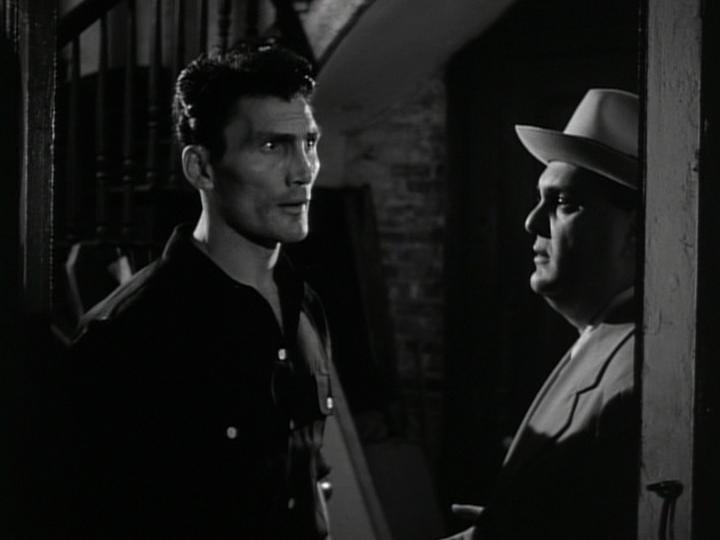Reportedly Steven Soderbergh’s 2011 film Contagion has captured the popular imagination in the midst of the coronavirus outbreak. I went back to Elia Kazan’s little-known and tightly directed Panic in the Streets for my fix.
In a great opening sequence, we join four men engrossed in a card game in a seedy upstairs apartment on a sticky New Orleans night. One, named Kochak, has the sweats and in broken English complains of sickness, rushing out to the night air. The other three – Blackie (a sprung Jack Palance in his debut role) and his henchmen Poldi (Guy Thomajan) and Fitch (a blacklisted Zero Mostel) – pursue Kolchak, believing he’s feigning illness to escape a losing game and determined to collect the money they’re owed. The chase staggers across the railway tracks to the riverfront. Blackie stalks his prey, herding him into the shadows of a narrow passageway allowing the others to close in. A knife is drawn, shots are fired and Kochak’s body is dumped in the Mississippi. It’s a thrilling scene, beautifully composed.
The police autopsy reveals Kochak is carrying the pneumonic plague, a variant of the bubonic plague that killed 50 million in the middle ages. Public health officer Clinton Reed (Richard Widmark) and police Captain Warren (Paul Douglas) have 48 hours to find the men who associated with the victim before they become contagious and start a deadly epidemic.

The film makes great use of real locations in New Orleans. The opening credits glide down Bourbon Street and there are scenes I recognised in Frenchtown’s Royal Street and Decatur Street. It looks seedy and dangerous. We also visit Reed’s family home in the Garden District and the obelisk in Lafayette Square near the courthouse. But the heart of the film is in the wharfs and docks, the warehouses and boats (a rehearsal for Kazan’s future On The Waterfront), including a chase scene under the wooden piers that reminded me of the end of Touch of Evil. The city gives texture and authenticity and the camera pans and glides to explore it to the full – the more conventional static shots are reserved for police station and domestic interiors.
The soundtrack forgoes the typical heavy-handed studio orchestras in favour of New Orleans jazz, mostly drifting from nightclubs, jukeboxes and radios. Apparently, Kazan made lots of friends amongst the New Orleans musicians and used them for the soundtrack. There aren’t any scenes showcasing musical numbers, instead the music is carried in the air, permeating the film, lending it atmosphere.

Reed and Warren are an odd couple. The former – a clean-cut family man – is earnest and well-intentioned but naive and self-critical. By contrast, the cop is cynical and a touch lazy, a hanger-on. The relationship is a prototype buddy-movie pairing with an arc that moves from distrust to mutual respect. It’s entertaining because both men are flawed, each with their own methods that lead to frustrating failure as much as breakthrough results.
But as is often the case, the villains are more interesting than the heroes, particularly the relationship between Blackie and henchman Fitch. Blackie is played with an uncaring cruelty by Palance, his skull-like features and height give him a domineering, sinister presence. Mostel plays Fitch almost for laughs, nervous, unfit, weak yet loyal. They make a great double-act.
Palance’s physical performance is particularly impressive. Lithe and powerful, he obviously performed many of his own stunts, including in a gripping extended shoot-out and chase scene through the warehouses and waterfront. There’s also a scene of surprisingly abrupt, selfish cruelty from Blackie that had the audience gasping and that’s almost as shocking as the coffee cup scene in The Big Heat.

The dialogue is taut and inventive, and the plot is mostly fast-paced. It’s only slowed by a few dated and unnecessary domestic scenes with a sympathetic but ultimately bland performance by Barbara Bel Geddes as Reed’s wife, although this does give the narrative a human scale. But mostly this is an impressive and taut thriller, the race-against-time give momentum and the snappy dialogue and characterisation keep the stakes high.
In the end the promised panic in the streets may not materialise, but the film’s an entertaining and unusual thriller that deserves to be better known.


[…] time with lesser known films including his debut A Tree Grows in Brooklyn (1945), Boomerang (1947), Panic in the Streets (1950), A Face in the Crowd (1957), Wild River (1960) and America, America (1963). They made me […]
LikeLike
Terrific thriller. PALANCE deserved Oscar. Great review.
LikeLiked by 1 person
Thanks. I really enjoyed the film.
LikeLike